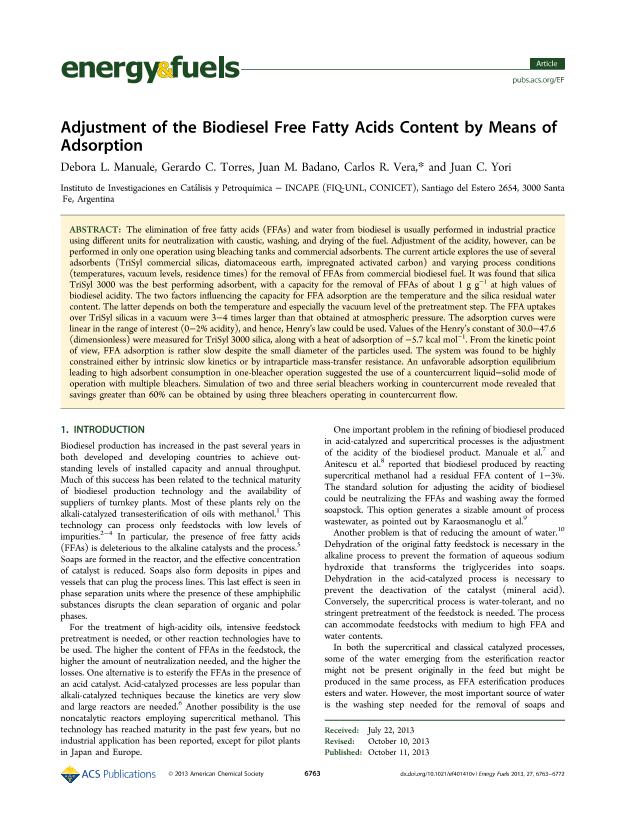Mostrar el registro sencillo del ítem
dc.contributor.author
Manuale, Débora Laura

dc.contributor.author
Torres, Gerardo Carlos

dc.contributor.author
Badano, Juan Manuel

dc.contributor.author
Vera, Carlos Roman

dc.contributor.author
Yori, Juan Carlos

dc.date.available
2017-08-28T19:15:58Z
dc.date.issued
2013-10
dc.identifier.citation
Manuale, Débora Laura; Torres, Gerardo Carlos; Badano, Juan Manuel; Vera, Carlos Roman; Yori, Juan Carlos; Adjustment of the Biodiesel Free Fatty Acids Content by Means of Adsorption; American Chemical Society; Energy & Fuels (print); 27; 11; 10-2013; 6763-6772
dc.identifier.issn
0887-0624
dc.identifier.uri
http://hdl.handle.net/11336/23155
dc.description.abstract
The elimination of free fatty acids (FFAs) and water from biodiesel is usually performed in industrial practice using different units for neutralization with caustic, washing, and drying of the fuel. Adjustment of the acidity, however, can be performed in only one operation using bleaching tanks and commercial adsorbents. The current article explores the use of several adsorbents (TriSyl commercial silicas, diatomaceous earth, impregnated activated carbon) and varying process conditions (temperatures, vacuum levels, residence times) for the removal of FFAs from commercial biodiesel fuel. It was found that silica TriSyl 3000 was the best performing adsorbent, with a capacity for the removal of FFAs of about 1 g g–1 at high values of biodiesel acidity. The two factors influencing the capacity for FFA adsorption are the temperature and the silica residual water content. The latter depends on both the temperature and especially the vacuum level of the pretreatment step. The FFA uptakes over TriSyl silicas in a vacuum were 3–4 times larger than that obtained at atmospheric pressure. The adsorption curves were linear in the range of interest (0–2% acidity), and hence, Henry’s law could be used. Values of the Henry’s constant of 30.0–47.6 (dimensionless) were measured for TriSyl 3000 silica, along with a heat of adsorption of −5.7 kcal mol–1. From the kinetic point of view, FFA adsorption is rather slow despite the small diameter of the particles used. The system was found to be highly constrained either by intrinsic slow kinetics or by intraparticle mass-transfer resistance. An unfavorable adsorption equilibrium leading to high adsorbent consumption in one-bleacher operation suggested the use of a countercurrent liquid–solid mode of operation with multiple bleachers. Simulation of two and three serial bleachers working in countercurrent mode revealed that savings greater than 60% can be obtained by using three bleachers operating in countercurrent flow.
dc.format
application/pdf
dc.language.iso
eng
dc.publisher
American Chemical Society

dc.rights
info:eu-repo/semantics/openAccess
dc.rights.uri
https://creativecommons.org/licenses/by-nc-sa/2.5/ar/
dc.subject
Biodiesel
dc.subject
Adsorbents
dc.subject
Free Fatty Acids
dc.subject.classification
Otras Ingeniería Química

dc.subject.classification
Ingeniería Química

dc.subject.classification
INGENIERÍAS Y TECNOLOGÍAS

dc.title
Adjustment of the Biodiesel Free Fatty Acids Content by Means of Adsorption
dc.type
info:eu-repo/semantics/article
dc.type
info:ar-repo/semantics/artículo
dc.type
info:eu-repo/semantics/publishedVersion
dc.date.updated
2017-08-15T17:59:44Z
dc.journal.volume
27
dc.journal.number
11
dc.journal.pagination
6763-6772
dc.journal.pais
Estados Unidos

dc.journal.ciudad
Washington
dc.description.fil
Fil: Manuale, Débora Laura. Consejo Nacional de Investigaciones Científicas y Técnicas. Centro Científico Tecnológico Conicet - Santa Fe. Instituto de Investigaciones en Catálisis y Petroquímica "Ing. José Miguel Parera". Universidad Nacional del Litoral. Instituto de Investigaciones en Catálisis y Petroquímica "Ing. José Miguel Parera"; Argentina
dc.description.fil
Fil: Torres, Gerardo Carlos. Consejo Nacional de Investigaciones Científicas y Técnicas. Centro Científico Tecnológico Conicet - Santa Fe. Instituto de Investigaciones en Catálisis y Petroquímica "Ing. José Miguel Parera". Universidad Nacional del Litoral. Instituto de Investigaciones en Catálisis y Petroquímica "Ing. José Miguel Parera"; Argentina
dc.description.fil
Fil: Badano, Juan Manuel. Consejo Nacional de Investigaciones Científicas y Técnicas. Centro Científico Tecnológico Conicet - Santa Fe. Instituto de Investigaciones en Catálisis y Petroquímica "Ing. José Miguel Parera". Universidad Nacional del Litoral. Instituto de Investigaciones en Catálisis y Petroquímica "Ing. José Miguel Parera"; Argentina
dc.description.fil
Fil: Vera, Carlos Roman. Consejo Nacional de Investigaciones Científicas y Técnicas. Centro Científico Tecnológico Conicet - Santa Fe. Instituto de Investigaciones en Catálisis y Petroquímica "Ing. José Miguel Parera". Universidad Nacional del Litoral. Instituto de Investigaciones en Catálisis y Petroquímica "Ing. José Miguel Parera"; Argentina
dc.description.fil
Fil: Yori, Juan Carlos. Consejo Nacional de Investigaciones Científicas y Técnicas. Centro Científico Tecnológico Conicet - Santa Fe. Instituto de Investigaciones en Catálisis y Petroquímica "Ing. José Miguel Parera". Universidad Nacional del Litoral. Instituto de Investigaciones en Catálisis y Petroquímica "Ing. José Miguel Parera"; Argentina
dc.journal.title
Energy & Fuels (print)

dc.relation.alternativeid
info:eu-repo/semantics/altIdentifier/url/http://pubs.acs.org/doi/abs/10.1021/ef401410v
dc.relation.alternativeid
info:eu-repo/semantics/altIdentifier/doi/http://dx.doi.org/10.1021/ef401410v
Archivos asociados
